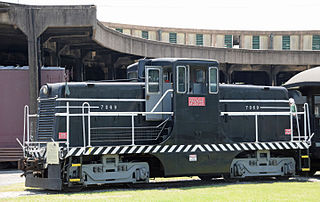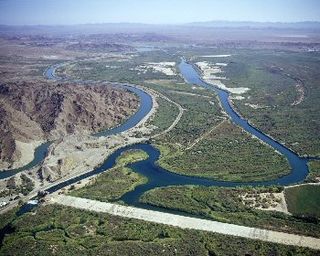
A diesel locomotive is a type of railway locomotive in which the power source is a diesel engine. Several types of diesel locomotives have been developed, differing mainly in the means by which mechanical power is conveyed to the driving wheels. The most common are diesel-electric locomotives and diesel-hydraulic.

The Virginia and Truckee Railroad is a privately owned heritage railroad, headquartered in Virginia City, Nevada. Its private and publicly owned route is 14 miles (23 km) long. When first constructed in the 19th century, it was a commercial freight railroad which was originally built to serve the Comstock Lode mining communities of northwestern Nevada.

The North Carolina Transportation Museum is a museum in Spencer, North Carolina. It is a collection of automobiles, aircraft, and railway vehicles. The museum is located at the former Southern Railway's 1896-era Spencer Shops and devotes much of its space to the state's railroad history. The museum has the largest collection of rail relics in the Carolinas. Its Back Shop building of nearly three stories high is notable for its size, two football fields long.

The GE 44-ton switcher is a four-axle diesel-electric locomotive built by General Electric between 1940 and 1956. It was designed for industrial and light switching duties, often replacing steam locomotives that had previously been assigned these chores.

The Durango and Silverton Narrow Gauge Railroad, often abbreviated as the D&SNG, is a 3 ft (914 mm) narrow-gauge heritage railroad that operates on 45.2 mi (72.7 km) of track between Durango and Silverton, in the U.S. state of Colorado. The railway is a federally-designated National Historic Landmark and was also designated by the American Society of Civil Engineers as a National Historic Civil Engineering Landmark in 1968.
The Santa Maria Valley Railroad is a 14.8 miles (23.8 km) shortline railroad that interchanges with the Union Pacific Railroad's Coast Line at Guadalupe, California. As of 2006, the Railroad is owned by the Coast Belle Rail Corporation.

The GE 80-ton switcher is a diesel-electric locomotive model built by GE Transportation Systems. It is classified as a B-B type locomotive. It was designed for industrial and light switching duties around railheads and ports.
The 5-mile (8.0 km) Reader Railroad was a tourist-only railroad operating in Reader, Arkansas from 1973 to 1991. As a 23-mile (37 km) common carrier prior to May 1973, it was the last all steam locomotive-powered, mixed train railroad operating in North America. It operated trackage in Ouachita County and Nevada County, Arkansas. The five mile tourist railroad operated until 1991, when it could not meet the new federal safety regulations.

The GE 45-ton switcher is a 4-axle diesel locomotive built by General Electric between 1940 and 1956.

The Museum of the American Railroad, formerly known as the Age of Steam Railroad Museum, is a railroad museum in Frisco, Texas. The museum has more than 70 pieces of steam, diesel, passenger, and freight railroad equipment sitting on 15 acres making it one of the largest historic rail collections in the US. Guests may walk through some of the equipment on guided tours.

The Fort Eustis Military Railroad is an intra-plant United States Army rail transportation system existing entirely within the post boundaries of the United States Army Transportation Center and Fort Eustis (USATCFE), Fort Eustis, Virginia. It has served to provide railroad operation and maintenance training to the US Army and to carry out selected material movement missions both within the post and in interchange with the US national railroad system via a junction at Lee Hall, Virginia. It consists of 31 miles (50 km) of track broken into three subdivisions with numerous sidings, spurs, stations and facilities.

The Texas Transportation Museum (TTM) is a transportation museum located in San Antonio, Texas.

The Rio Grande Scenic Railroad of Colorado was a heritage railway that operated from 2006 to 2019 in and around the San Luis Valley as a subsidiary of the San Luis and Rio Grande Railroad. The heritage railroad ceased operating excursions following a wildfire that damaged some of their facilities, as well as the parent company SLRG entering Chapter 11 bankruptcy in late 2019.

The Yuma Project is a U.S. Bureau of Reclamation project built to irrigate over 68,000 acres (280 km2) of land in Yuma County, Arizona and parts of Imperial County, California. The project is designed to exploit year-round farming conditions and water from the Colorado River. It consists of the Laguna Diversion Dam, pumping plants, a power plant, a 53-mile (85 km) system of canals, 218 miles (351 km) of lateral canals, levees and drains. The project began in 1903 and the majority of the work was completed by 1915. It was the first dam and reclamation project on the Colorado River and workers had to overcome many natural and logistical obstacles to build and maintain it. The Laguna Diversion Dam was replaced by the Imperial Dam as the Project's water source between 1941 and 1948. Today, it serves 275 farms and over 94,000 people.

Steamboats on the Colorado River operated from the river mouth at the Colorado River Delta on the Gulf of California in Mexico, up to the Virgin River on the Lower Colorado River Valley in the Southwestern United States from 1852 until 1909, when the construction of the Laguna Dam was completed. The shallow draft paddle steamers were found to be the most economical way to ship goods between the Pacific Ocean ports and settlements and mines along the lower river, putting in at landings in Sonora state, Baja California Territory, California state, Arizona Territory, New Mexico Territory, and Nevada state. They remained the primary means of transportation of freight until the advent of the more economical railroads began cutting away at their business from 1878 when the first line entered Arizona Territory.

The Colebrookdale Railroad, also known as the Secret Valley Line or colloquially as The Colebrookdale, is a tourist railroad located in the U.S. state of Pennsylvania. The railroad operates between Boyertown in Berks County and Pottstown in Montgomery County.

The Southern California Railway Museum, formerly known as the Orange Empire Railway Museum, is a railroad museum in Perris, California, United States. It was founded in 1956 at Griffith Park in Los Angeles before moving to the former Pinacate Station as the "Orange Empire Trolley Museum" in 1958. It was renamed "Orange Empire Railway Museum" in 1975 after merging with a museum then known as the California Southern Railroad Museum, and adopted its current name in 2019. The museum also operates a heritage railroad on the museum grounds.
Barstow Yard is a classification yard operated by Burlington Northern Santa Fe Railway (BNSF) in Barstow, California. With 48 directional tracks and a total area of approximately 600 acres (240 ha), it is the second largest classification yard west of the Rocky Mountains after the JR Davis Yard. Today, almost all freight traffic to and from Southern California runs through the junction.

The GE 25-ton switcher is a model of diesel-electric switcher locomotive that was produced by GE Transportation at their Erie, Pennsylvania, facility between 1941 and 1974. Most examples were produced for industrial customers or the United States Armed Forces, although a number of examples were purchased by freight railroads as well. The majority of production was for customers in the United States and Canada, but export models were produced for buyers on five continents. Production totaled approximately 550 units over 33 years, making it one of the most widely produced switchers in American history.















